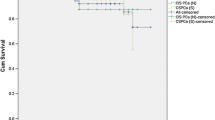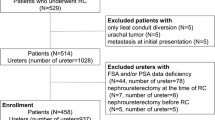Abstract
Prostate involvement is a major prognostic element in urothelium carcinoma staging after radical cystoprostatectomy (RCP) for muscle invasive bladder cancer. While appropriate pTNM stage is necessary for adequate treatment, no standard procedure exists up to now for macroscopic sampling of the prostate in RCP in daily practice. We therefore propose a protocol where examination of the whole prostatic urethra (PU) is possible, without using whole mount sections. From 2008 to June 2009, RCP were sampled according to a macroscopic protocol permitting the whole length and the underlying stroma of PU to be visualized. Data were compared with our series or RCP from 2000–2007, when the PU was evaluated with a more simple protocol. One hundred and one specimens were examined between 2000–2007, 25 until June 2009. In the latter series, we found pT4 bladder cancer in 36% versus 21%, Cis in the PU in 28% versus 14%, and additional prostate cancer was seen in 44% compared with 13% (p = 0.0004) in the 2008–2009 group versus the 2000–2007 group, respectively. Our proposed protocol better detects prostate involvement by bladder cancer, therefore providing a better final stage of the patients. We propose a macroscopic protocol where the whole PU and the underlying stroma can be examined without the use of whole mount sections. Data are similar to those published in the recent literature, where whole mount sections were used. This protocol also permits better detection of concomitant prostate carcinomas.




Similar content being viewed by others
References
Stenzl A, Cowan N, De Santis M et al (2009) The updated EAU guidelines on muscle-invasive and metastatic bladder cancer. Eur Urol 55:815–825
Eble JN, SG EJI, Sesterhenn IA (2004) WHO classification of tumors. Tumors of the genitourinary and male genital organs. IARC Press, Lyon
Montironi R, Cheng L, Mazzucchelli R et al (2009) Critical evaluation of the prostate from cystoprostatectomies for bladder cancer: insights from a complete sampling with the whole mount technique. Eur Urol 55:1305–1309
Lopez-Beltran A, Bassi P, Pavone-Macaluso M, Montironi R (2004) Handling and pathology reporting of specimens with carcinoma of the urinary bladder, ureter, and renal pelvis. Eur Urol 45:257–266
Wheeler TM (1989) Anatomic considerations in carcinoma of the prostate. Urol Clin North Am 16:623–634
Shen SS, Lerner SP, Muezzinoglu B et al (2006) Prostatic involvement by transitional cell carcinoma in patients with bladder cancer and its prognostic significance. Hum Pathol 37:726–734
Mazzucchelli R, Barbisan F, Santinelli A et al (2009) Prediction of prostatic involvement by urothelial carcinoma in radical cystoprostatectomy for bladder cancer. Urology 74:385–390
Liedberg F, Chebil G, Mansson W (2007) Urothelial carcinoma in the prostatic urethra and prostate: current controversies. Expert Rev Anticancer Ther 7:383–390
Ayyathurai R, Gomez P, Luongo T et al (2007) Prostatic involvement by urothelial carcinoma of the bladder: clinicopathological features and outcome after radical cystectomy. BJU Int 100:1021–1025
Donat SM, Genega EM, Herr HW, Reuter VE (2001) Mechanisms of prostatic stromal invasion in patients with bladder cancer: clinical significance. J Urol 165:1117–1120
Lerner SP, Shen S (2008) Pathologic assessment and clinical significance of prostatic involvement by transitional cell carcinoma and prostate cancer. Urol Oncol 26:481–485
Esrig D, Freeman JA, Elmajian DA et al (1996) Transitional cell carcinoma involving the prostate with a proposed staging classification for stromal invasion. J Urol 156:1071–1076
Herr HW, Donat SM (1999) Prostatic tumor relapse in patients with superficial bladder tumors: 15-year outcome. J Urol 161:185–187
Revelo MP, Cookson MS, Chang SS et al (2004) Incidence and location of prostate and urothelial carcinoma in prostates from cystoprostatectomies: implications for possible apical sparing surgery. J Urol 171:646–651
Acknowledgement
We thank Annette Lesourd and Gilles Le Naour for perfect technical assistance.
Conflict of interest
We declare that we have no conflict of interest.
Author information
Authors and Affiliations
Corresponding author
Rights and permissions
About this article
Cite this article
Varinot, J., Camparo, P., Roupret, M. et al. Full analysis of the prostatic urethra at the time of radical cystoprostatectomy for bladder cancer: impact on final disease stage. Virchows Arch 455, 449–453 (2009). https://doi.org/10.1007/s00428-009-0849-0
Received:
Revised:
Accepted:
Published:
Issue Date:
DOI: https://doi.org/10.1007/s00428-009-0849-0




